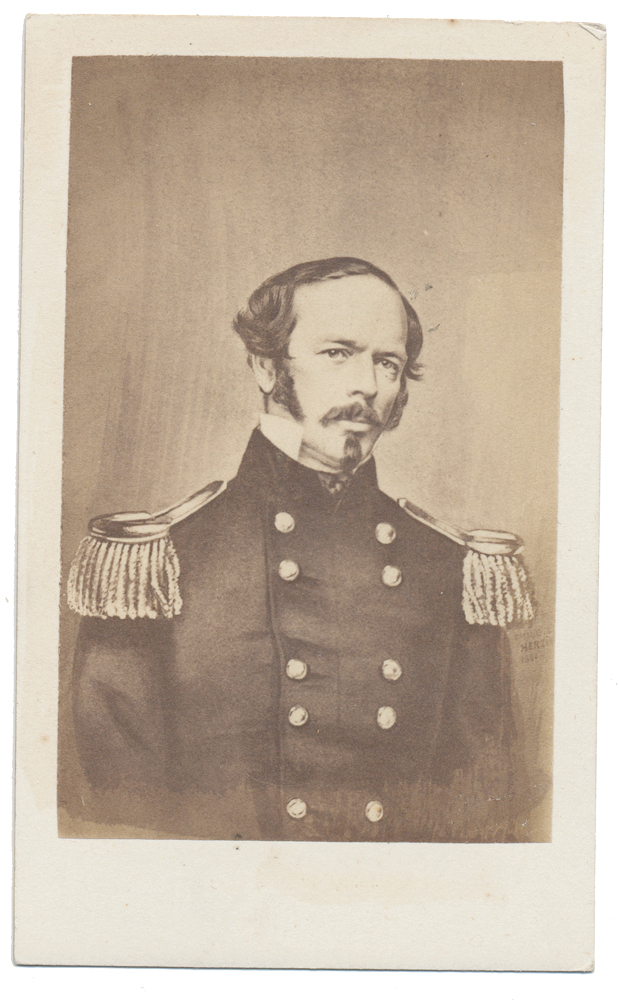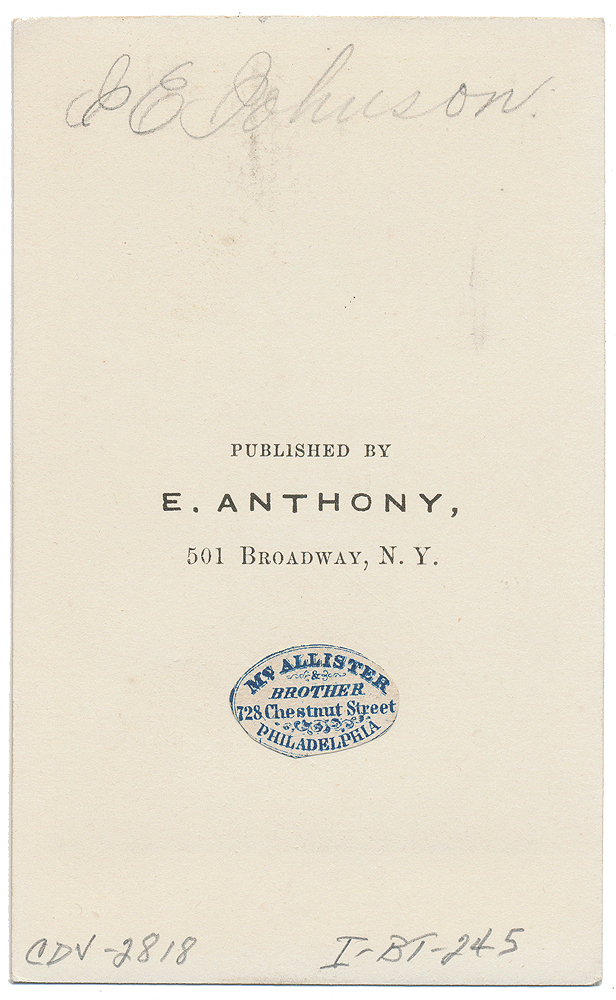site search
online catalog
EARLY WAR VIEW OF CONFEDERATE GENERAL JOSEPH E. JOHNSTON – EX WILLIAM A. TURNER COLLECTION

Hover to zoom


$100.00
Quantity Available: 1
Item Code: 1138-245
Shipping: Determined by Method & Location of buyer
To Order:
Call 717-334-0347,
Fax 717-334-5016, or E-mail
Image is a waist-up view of Johnston in the painted in uniform of the United States army.
Clarity and contrast are good. Paper and mount are also nice.
Reverse photographer’s mark for E. ANTHONY…NEW YORK with a small period sticker for MCALLISTER & BROTHER… PHILADELPHIA. There is also some collector information in pencil. Top of reverse has a pencil inscription of “J. E. JOHNSON.”
Joseph Eggleston Johnston was born February 3, 1807 near Farmville, Virginia. He attended West Point from 1825 to 1829 and graduated 13th in a class of 46 with Robert E. Lee ranking 2nd in the same class. Johnston was assigned as a 2nd Lieutenant to the 4th Artillery.
Johnston resigned from the Army in 1837 to study civil engineering. After serving as a civilian engineer with the Army in the Second Seminole War Johnston rejoined the Army on July 7, 1838 and was commissioned a 1st Lieutenant in the Topographical Engineers. The same day he was given a brevet promotion to Captain for his services in Florida.
During the Mexican War Johnston served on the staff of General Winfield Scott. He took part in the siege of Vera Cruz and was wounded at Cerro Gordo. For his actions in the latter battle he received another brevet promotion to Lieutenant Colonel. He returned to the Army from his wound while it was at Puebla. He went on to distinguish himself at Contreras, Churubusco and was wounded again at Chapultepec. He ended the war as a brevet Colonel. After the war he reverted to his regular rank of Captain.
Johnston served in Texas after the war and was eventually appointed Lieutenant Colonel of the 1st U.S. Cavalry at Fort Leavenworth, Kansas in 1855. While here he fought the Sioux in Wyoming and was involved in some of the “BLEEDING KANSAS” actions. Johnston was promoted to Brigadier General and appointed Quartermaster of the Army in 1860.
When the Civil War broke out Johnston resigned from the Army to accept a commission as a Brigadier General in the Confederate Army. He helped lead the Confederate forces to victory in the 1st Bull Run Campaign.
In August of 1861 Johnston was made a full General and commanded the Army of Northern Virginia till his wounding at Fair Oaks. Upon recovery Johnston was sent to the western theater where he served as Department of the West Commander.
After the removal of Braxton Bragg Johnston became the commander of the Army of Tennessee. It was a position he held from December of 1863 to July 17, 1864. In the middle of the siege of Atlanta President Davis replaced Johnston with John Bell Hood. Johnston was once again placed at the head of the Army of Tennessee in early 1865 and commanded it till the end of the war surrendering to Sherman in April of 1865.
After the war he worked in the railroad business and served in Congress. When General Sherman died Johnston served as an honorary pallbearer at his funeral; during the procession in New York City on February 19, 1891, he kept his hat off as a sign of respect in the cold, rainy weather. Someone with concern for the old general's health asked him to put on his hat, to which Johnston replied "If I were in his place and he were standing here in mine, he would not put on his hat." He caught a cold that day, which developed into pneumonia, and he died several weeks later on March 21, 1891 in Washington, D.C. He was buried next to his wife in Green Mount Cemetery, Baltimore, Maryland. [ad] [ph:L]
~~~~~~~~~~~~~~~~~~~~~~~~~~~~~~~~~~~
THIS ITEM, AS WITH ALL OTHER ITEMS AVAILABLE ON OUR WEB SITE,
MAY BE PURCHASED THROUGH OUR LAYAWAY PROGRAM.
CLICK HERE FOR OUR POLICIES AND TERMS.
THANK YOU!
Inquire About EARLY WAR VIEW OF CONFEDERATE GENERAL JOSEPH E. JOHNSTON – EX WILLIAM A. TURNER COLLECTION
Most Popular
Historical Firearms Stolen From The National Civil War Museum In Harrisburg, Pa »
Theft From Gravesite Of Gen. John Reynolds »
Selection Of Unframed Prints By Don Troiani »
Fine Condition Brass Infantry Bugle Insignia »
Large English Bowie Knife With Sheath 1870’S – 1880’S »
Imported (Clauberg) Us Model 1860 Light Cavalry Officer's Saber »
featured item
NEAR EXCELLENT CONDITION COLT M1851 NAVY
A near excellent Middle Fourth Model Colt M1851 Navy, with all-matching serial number 141159, to which the Colt site assigns an 1863 production date. This model falls in the #118000-#16800 range, overlapping with earlier and particularly later… (302-123). Learn More »


